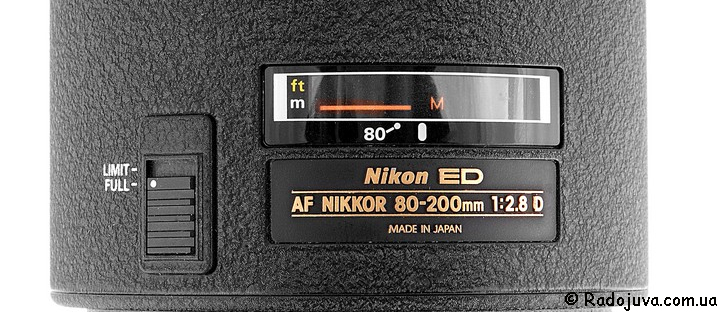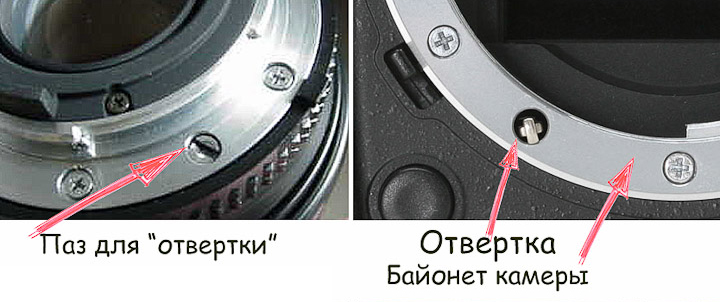On the network you can find different information about the speed of automatic focusing lenses Nikon Nikkor type 'AF' with different cameras. In this article, you can find some thoughts about this.
Lenses for Nikon Cameras type 'AF' do not have a built-in focusing motor and, during automatic focusing, the focusing motor located in the camera itself is engaged in moving the lenses to focus on focus. This motor is most often referred to as a 'screwdriver' by Nikon users, as the transmission from camera to lens really resembles a screwdriver.
A 'screwdriver' rotates and, through a special 'receiver' on the lens, transmits a torque to the internal mechanism of the lens, which moves the lenses, producing focus. If a disassemble the camera, the built-in focusing motor will turn out to be very small in size, sometimes you might even wonder how it can move huge and heavy lenses on large lenses.
So, there is an opinion that the 'cooler' the camera, the faster it focuses. So, you can find information that TOP cameras Nikon D1, D2 series, D3, D4 have noticeably faster focusing with 'AF' type lenses than other cameras.
Experiment 1. I had the opportunity to test two cameras of different levels - Nikon D80 (advanced mid-range amateur camera) and D700 (camera upper class) with lens Nikon ED AF Nikkor 80-200mm 1: 2.8D MKII.
More interesting videos can be viewed at my youtube channel.
Experiment 2. If we compare the focusing time with the lens Nikon ED AF Nikkor 80-200mm 1: 2.8D MKII on the old film camera Nikon AF N8008s and at the Central Control Commission Nikon D700, then the difference will be palpable:
This topic is quite interesting, so write your observations about the speed of focusing with different cameras in the comments.
Thank you for attention. Arkady Shapoval.


“Well, there is a popular belief that the 'cooler' the camera, the faster it focuses. So, you can find information that the TOP cameras of the Nikon D1, D2, D3, D4 series have noticeably faster focusing with 'AF' type lenses than other cameras. ”
Arkady the difference is still felt.
For example, I did not expect that there is a difference between the D700 and D3s. But it is and is felt on non-motorized fixes such as 35 / 2D or 50 / 1.4D. The difference between the D90 and D700 on these glasses is very easy to notice.
And the more difficult the lighting conditions are, the more it will be noticeable how the younger cameras “dull” and make mistakes.
Reply
Excuse me, but what is the relationship between the speed of rotation of the lens by the motor and the “focusing time”? First, not speed, but time. Secondly, you can twist the lens even with an 800 Watt perforator and in all directions. But if the automation gave a "flight", then no matter how fast the lens was - you need to stop and take a step back. And so it turns out "hunt" - well, that is, hunting for a trick. A more accurate and high-quality sensor will simply turn the autofocus into a clear position and stop. And here it is not particularly important how quickly the motor turns. It is important to clearly and in time to understand that you are in focus, and to stop the system so that there is no flight. And in this regard, the focusing time will differ fundamentally for the budget and the top-s. Although the motors may even stand the same
Reply
Of course, the focusing system is a closed ACS and the speed of operation depends on all the components of this ACS. But in this test, the lenses were driven from infinity to MDF, which most likely indicates the operation of the mechanical subsystem.
Reply
I’ll continue to make it clearer: the motor, for example, can accelerate the lens very well, but not a fact, then the focusing system as a whole will also be fast and vice versa.
Reply
The D3 and other cameras have even more powerful motors than the D700, screwdriver lenses focus much faster, not to say that the difference is twice, but 500 percent for sure. Actually, when I rearranged my Tamron 17-50 / 2.8 for Pentax from Pentax K-01 to Pentax K3, at first I thought that it suddenly deteriorated, the threads or something else in it cast or broke, there was a feeling that it had released from the shackles, she began to focus exactly 50% faster and almost without misses, but then I read on the Internet that Pentax, even in its K-S1 and newer cameras, began to install fast screwdriver motors. In the case of Nikon, it's about simple marketing - they inserted the fastest focusing motor into the top-end model. Now, when old top cameras can be bought for $ 1000 in excellent condition, personally I see no reason even for amateurs at least once in their lives not to try them and not to enjoy working with good cameras, at least to look like a pro. In addition, there the shutters are much more durable, and all the other parts and functions are also top-end ...
Reply
At 500% this is 5 times.
Reply
Even 6 times.
Reply
I will share my personal experience: I gave Nikon AF DC 105 1: 2D service to the service, the lens had mechanical damage to the inner tubes and part of the body. The repair was long in time, but in the end, high quality, however, from the second time :). The first time, when I received a lens from repair, I saw that autofocus works extremely slowly, and not just slowly, but with obvious “jamming” in the infinity range (D800 camera). I removed the lens from the camera and twisted the autofocus screw with an ordinary screwdriver, found that there is a clear effort that increases near infinity. I compared the effort on other screwdriver lenses - it is very weak and, surprisingly, equally weak on both the small 35 AF 1: 2D and the large 80-200 AF 1: 2,8D (that's why the small motor in the camera turns the large lenses easily in lenses :)). I sent the lens back to the service, they conducted experiments and that's what they said. After the repair, they checked the work on the D3, they did not notice any autofocus brakes, when I returned the lens to them, they checked it on the D750 - they saw the same brakes as on the D800, and checked on the D610 - it could not turn the autofocus of this lens at all. They said that there are two ways out - to order two more parts that need to be replaced (for money) or send them my camera and they will make the D800 turn as fast as the D3 (free). Based on this, it can be assumed that the motors in the cameras may be the same, but there is a limitation of the motor current, which can be regulated in the service (by software or hardware). Those. Nikon's service itself actually confirmed that the motors have different torque in different chambers. This limitation is most likely caused by the focusing modules of simpler cameras, which simply do not have enough tenacity and accuracy at a high motor speed, as Arkady wrote in the article.
Reply
D810 D7100 AT 810 MOTOR POWERFUL SPINS faster AF azhna on the focusing ring on the lens play appears 7100 smoothly softer quieter spins slower
Reply
You intentionally do not put punctuation marks, so that it is more difficult to understand what you wrote about? Should there be a mystery in every person?
Reply